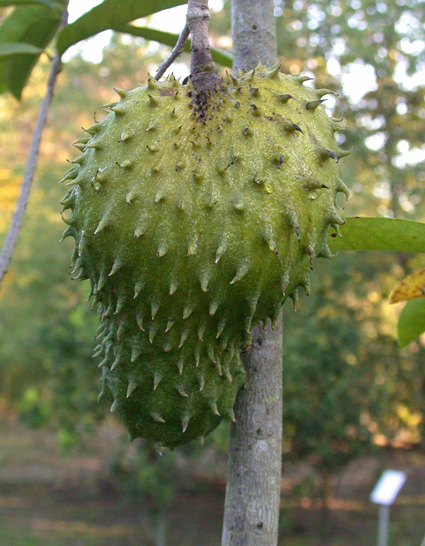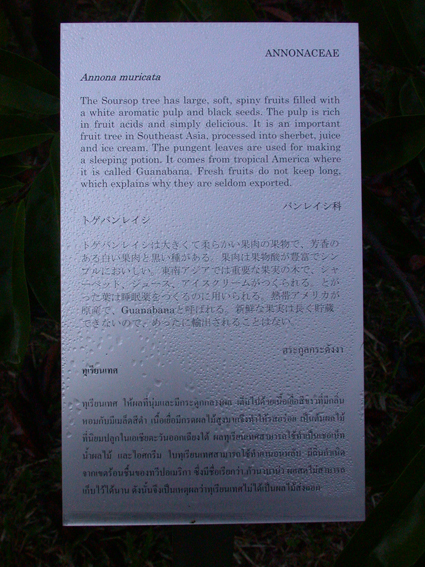December is a good time to harvest thurian thet
Locals who have never been further away than 4 km from their village ask us with hesitation whether Dokmai Garden’s large, spiny, green fruits are ‘thurian’ (durian) or not? They are ‘thurian thet’ in the Central Thai language, or ‘soursop’ or ‘guanabana’ in English (Annona muricata, Annonaceae).

Yesterday evening I had my first fruit in a long while. It was huge and in perfect eating condition; so soft you could peel it by hand and eat the white pulp with a tablespoon. In fact, taste and texture reminds me of a fruit yoghourt.
Although this Central and South American plant is easy to grow in the Chiang Mai valley, I rarely see it here and I have never seen its fruit in any Thai fruit market. It seems much more common elsewhere in Southeast Asia, such as Vietnam. The Seehamongkol family do not like soursop due to its acidity, so I can enjoy all fruits produced here at Dokmai Garden.
Ketsanee likes ‘noina’, i.e. sweetsop or custard apple (Annona squamosa) which grows in many Chiang Mai gardens, and which is often for sale in the local markets. My experience of that fruit here at Dokmai Garden is that without bagging (or pesticides if you are still into chemical gardening) the fruits mummify due to thirsty insects. All you get without precaution are small, black and dry fruits which remind me of shrunken heads. Soursop seems to stand the insects much better.
I bought one soursop sapling a few years ago which was in a terrible condition, so I had to cut it down to stimulate the growth of new shoots. Since then I have transplanted five more from cuttings from this original specimen, and yesterday’s fruit was from one of those cuttings. The cuttings smell soursop – a most appealing experience! A 30 cm woody cutting is simply stripped from its leaves and inserted into moist sand and kept under shade until the new leaves sprout. A couple of weeks after that you transplant to a sunny or partly sunny place. At Dokmai garden we water these fruit trees all year round, and they grow much easier than durian (Durio zibethinus, Malvaceae) which is not related (different family, different flavour, different continent).
The international name Annona muricata was coined by Linnaeus in 1753. ‘Annona’ is the Latinized form of the vernacular name for the related cherimoya fruit (Annona cherimola) in the American indian language Taino. ‘Muricata’ means ‘shaped like murex’, Aristotle’s name for a marine mollusk with spines used for the production of purple dye. When Linnaeus wrote “pomis muricatus” in the species description he meant that the fruits have spines, but they are soft. I have only seen real cherimoya once in Thailand, at Ketsanee’s land in Mae Khanin Tai in the nearby Opkhan national park. I have not had the time to transplant it to Dokmai Garden yet.
VIP card holders can pick up seeds or cuttings of soursop for free as long as they are available. If you have an organic fruits and vegetables account with us, come and harvest!
Does anyone in Thailand or Laos have seeds of Rollinia deliciosa? It is high on our wanted list.
Text & Photo: Eric Danell

Morning dew at 08 a.m.



Seeds of Rollinia deliciosa should be available in Hawaii. I’ll check for you; in fact, your subscriber Oscar, of Fruit Lover’s Nursery, should have them.
We are most grateful!
I wish I had known you needed Rolliinia. I could’ve smuggled some over earlier this year from Brisbane! Good to know that Soursop has less problems than custard apple. We have had almost no luck with our custard apples organically grown at Panya. We need to get some soursops growing!
Incidentally, have you managed to fruit any real thurians? It seems too cold at Panya for them to grow at all.
Dear Adam,
Please feel free to come and pick up cuttings and seeds of soursop! I feel sorry our mango grafting experiments have been postponed due to my fuzzy agenda. Right now is full season and loads of visitors so we work around the clock.
I have seen durian fruiting in Chaing Rai! The owner said he had a small tiny specimen for about ten years, and suddenly it grew like mad and made fruits. The trick is to plant other taller vegetation fairly densely around it, to maintain a moist atmosphere. If planted in full sun in this dry climate then durian will probably die even with irrigation. To my humble experience, jackfruit grows must faster too if planted in this way. Solitary trees struggle.
Cheers, Eric
Where can I buy some in Thailand. Preferably Chachoengsao
Soursop is unfortunately not so popular in Thailand. If you get hold of a tree ask for a cutting and you can soon produce your own fruits. Here at Dokmai Garden we have made several new trees from the original we bought.
Good luck!
Eric
ทุเรียนเทศ or soursop in English..
Please contact me. I am trying to help a young Cambodian girl with lymphoma in Bangkok. Trying to find soursop. Do you know where I can find it or purchase the juice?
Dear Johann,
Large scale production of soursop seems uncommon in Thailand, it is more grown as a curiosity. Soursop seems more common in Vietnamese markets. However, our Chiang Mai trees do not produce yet, they are seasonal.
Although many edible fruits can prevent some cancer forms by keeping membranes in good condition and by providing fibers and balance mineral and vitamin deficiencies, edible fruits rarely provide miracle cures against cancer. Anti-tumour compounds from the plant kingdom are generally terribly toxic in general, but especially to cells which divide quickly, such as cancer cells. A good example is paclitaxel (tradename taxol) from the yew tree (Taxus sp.) . The administration of toxic compounds with severe side effects must of course be made under the surveillance of physicians.
To make your friend feel stronger and to boost her immune system I should use a wide range of other organic and fresh fruits available as a complement to the hospital’s cancer treatment.
Your compassion is admirable!
Eric
Hi Eric,
I’m intrigued by your successful propagation of the soursop plant from cuttings.
A friend is going to give me some cuttings from his tree. Do I need to treat them with rooting hormone?
My experience from the hot Chiang Mai valley is that no hormones are needed to root soursop cuttings. Stick the leafless and woody cuttings in sand and keep the sand moist. Incubate in the shade. Best success is obtained if this is done during the early rainy season. The cool season in monsoon areas may slow down the root formation.
Good luck!
Eric
I’ve just arrived in Thailand and back home, I eat soursop regularly.
Do you sell them?
Sorry, the garden is private nowadays. Cheers, Eric